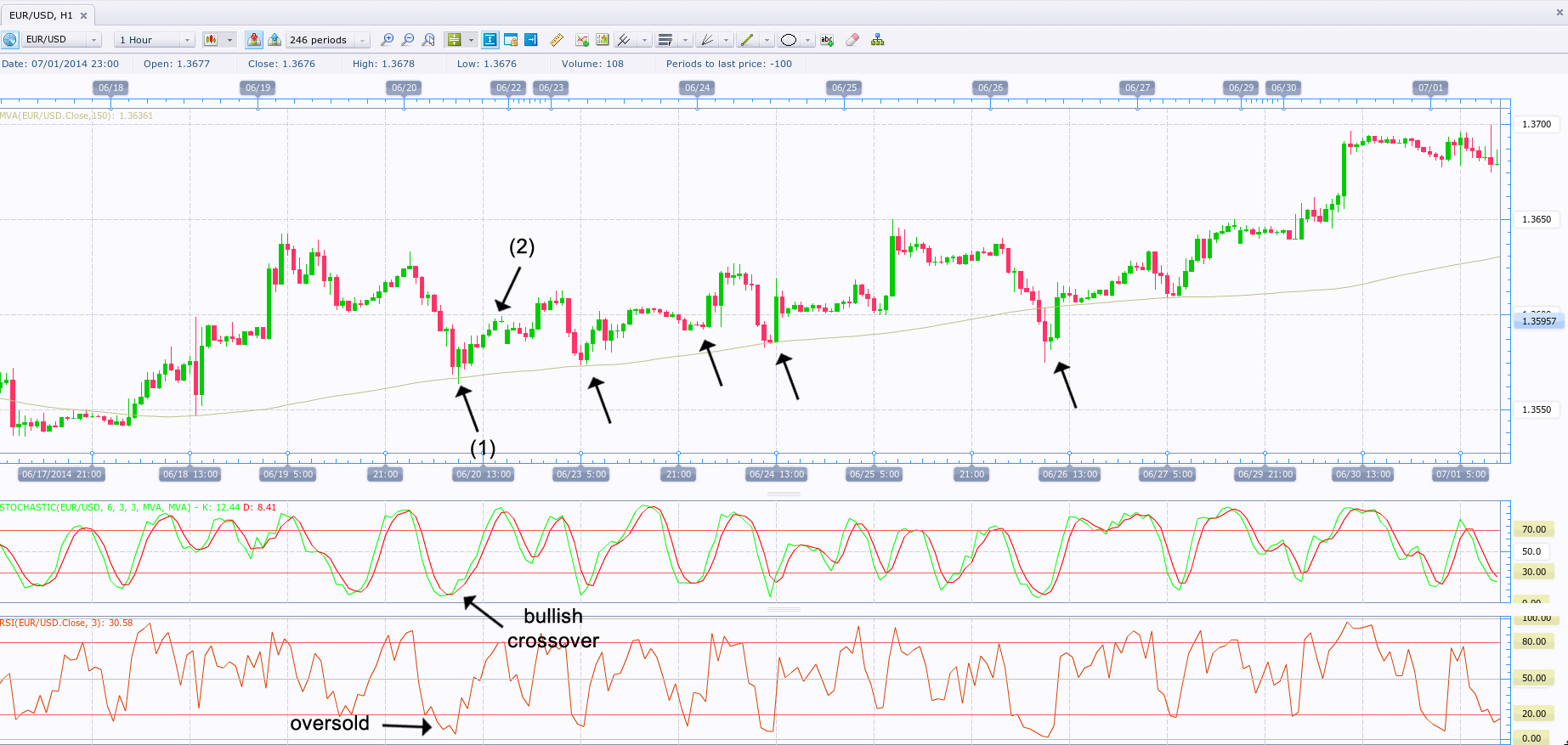Combining RSI, Full Stochastic Oscillator and SMA
You will learn about the following concepts
- Relative Strength Index
- Full Stochastic Oscillator
- SMA
- Combining the three
The current article will acquaint you with another useful and reliable trading system which is based on the combination of a slow Simple Moving Average, Full Stochastic Oscillator and Relative Strength Index.
It uses tight stop-loss protection, while ensuring high potential profits by producing accurate entry signals. It is best practiced on a daily time frame to limit the effects of whipsaws and can be used with any currency cross.
It consists of three indicators – a 150-period Simple Moving Average, a 3-period Relative Strength index with overbought and oversold levels at 70-80 and 30-20, respectively, and a Full Stochastic Oscillator with 6, 3, 3 settings and overall the same overbought/oversold areas.
The first condition which must be met to initiate a long entry is for the 150 SMA to be below the price action, thus signifying a bull trend. Once the Relative Strength Index drops in the oversold area, look for a bull crossover of the Stochastic lines, while they are also within their oversold zone (basically you need a bull trend with both indicators showing the market is oversold and with the Stochastic displaying a bull reversal).
Conversely, a short entry signal is generated when the 150 SMA is above the price action, signifying a bear trend, and RSI and the Stochastic are in the overbought area. As soon as the Stochastics fast and slow lines make a bearish crossover, you must enter short on the next price bar.
Stop-loss, profit target
We said that this strategy offers a high degree of capital protection because it places stop-loss levels at the most recent swing low. As for the profit target, as usual you can either use a fixed profit target where you can exit your entire position, or you can scale out upon reaching it and leave a portion in the market while protecting it with a trailing stop.
An exit signal is generated when the Stochastic reaches the opposite overbought/oversold level (overbought for a long position and vice versa). At that point you can either exit the entire trade, scale out of it and use a trailing stop, or keep the entire position and trail your stop. The trailing stop is typically placed below the low of the previous bar in a bull trend, or above the high of the previous bar in a bear trend. Check out the following screenshot.

We have used an hourly chart for the example above to show that it too can generate reliable signals, although whipsaws will be much more frequent compared to the daily time frame. As you can see, a strong and protracted bull trend was in motion, as indicated by the rising 150-period SMA. At bar (1) RSI was deep in the oversold area, while the Full Stochastic performed a bullish crossover, generating a long entry signal. Thus, we will enter above the high of bar 1, or at 1.3583 US dollars.
Our stop-loss is placed several pips (5-10) below the previous swing low (at 1.3547), thus we choose 1.3540. We remain on the market until the stochastic enters the opposite extreme area (in our case becomes overbought). At bar (2) the market became overbought and we exited our position at at its close, thus at 1.3596, scoring a profit of 13 pips. However, because this makes up for a too small risk-reward ratio, we might use a different management strategy to ensure better results.
We can instead remain on the market as the stochastic becomes overbought and immediately trail our stop to breakeven. As soon as we reach a 1:1 risk-reward ratio, we can scale out half of our position and leave the remainder on the market to capitalize on a possible extension of the up-move. For the second part of the trade you can trail your stop below the previous bars low and move it up as each new bull trend bar forms.
The market later generated several other possible long entry positions and each one of them could have at least earned a scalpers profit, while running very tight stops and keeping risk low. Thus, this strategy makes for a reliable trend trading system which relatively accurately pinpoints pullbacks in strong trends, and more importantly – their troughs, which as we know are the best with-trend entry points.